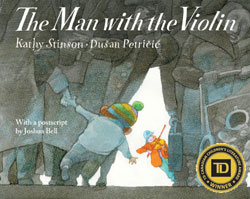Facts and Four Unanswered Questions About Maud Lewis

A Tulip In Winter sits alongside several other wonderful books on the CCBC’s Marilyn Baillie Picture Book Award shortlist and I’m delighted. I’m told it deserves to win. Of course, all the other titles do too!
I learned some fascinating things while conducting my research for the book, but sometimes what we learn leads to unanswerable questions. What, in this situation, is a writer to do?
Fact #1: When Maud was in grade five, she was fourteen years old.
Question: Was this because of her illness? Because she was bullied? Or because early in the twentieth century there wasn’t always a teacher available where she lived?
Solutions: I opted not to mention the fact. It was an interesting detail, but I couldn’t include all I learned about Maud, and I decided it was a detail not sufficiently important to the story of Maud’s life as an artist to make room for.
Fact #2: When Maud’s daughter, Catherine Dowley, showed up on her doorstep in 1950 (unlike what happens in the movie “Maudie”), Maud told Catherine she couldn’t be her daughter because she’d given birth to a baby boy who, very soon after, died.
Question: Was that because that’s what Maud had been told by her parents and she believed it? Because she didn’t want Everett to know about the baby she’d had years before they married? Or because she wanted to keep that painful part of her past behind her?
Solution: I decided that trying to put the shame of having a baby out of wedlock early in the 20th century into context for today’s young readers would not fit smoothly in a sparely and poetically written picture book. I love how Lauren Soloy suggested it in her art, as one of the “hardships” that visited Maud, without making too much of it.
Fact #3: Maud’s husband Everett did not spend money, even when he had it, on things that would have made their house more comfortable for Maud — things like electricity, a screen door, and indoor plumbing.
Question: Was Everett miserly and cruel, as some people believe? Was he simply content with how things were? Or was he afraid of spending money because of his own poor background?
Solution: I couldn’t ignore evidence in interviews and film footage that suggests Everett wasn’t an easy man to live with, but several other facts alongside this one helped with my decision as to how to depict the marriage.
- Many homes in rural Nova Scotia were without electricity and indoor plumbing at the time Maud and Everett lived there.
- Everett often appeared in Maud’s paintings as a strong and hard-working man.
- When Maud became ill, Everett tried to pay the ambulance driver what would have been for him a lot of money, in an attempt to convince the driver to take her to the hospital in Halifax, where he likely thought she’d get better treatment than she would in Digby.
- Near the end of her life Maud said, “I was loved.”
So, when I introduced him into the story, I wrote:
Everett Lewis was as gruff as a billy goat.
And I said:
Everett was strong in body. Maud was strong in spirit. They got along the way certain colours do.
Here is his last appearance in the story:
After a time, Maud was in too much pain to walk or even to paint.
Everett carried Maud to his wheelbarrow.
He pushed it to where she could see the sweet peas blooming.
“Thank you, Ev,” she said.“
In case I’d downplayed Everett’s “gruff as a billy goat” aspects more than I should have, I concluded in the book’s back matter that, whatever the nature of their marriage, Everett did make it possible for Maud to pursue her passion for painting, and she relieved him of a deep loneliness.
Fact #4: In contrast to the often bleak landscape and harsh climate of rural Nova Scotia that formed the backdrop of her life, Maud’s paintings brim with vivid, joyous colour.
Question: Was she escaping the miseries of her life through her painting? Or was she simply adept at seeing the beauty in the world and expressing it through her work?
Solution: I decided to let readers arrive at their own interpretation of the contrast between Maud’s joyfully exuberant art and her circumstances. (I may have steered them a little in the book’s back matter.)
I hope you find how I handled these dilemmas interesting, and agree that I made good decisions!
What biography have you read, or written, that left you wishing you could know more about its subject?
Share this post:

Kathy Stinson is the author of the classic Red Is Best and the award-winning The Man with the Violin. Her wide range of titles includes picture books, non-fiction, young adult fiction, historical fiction, horror, biography, series books, and short stories. She has met with her readers in every province and territory of Canada, in the United States, Britain, Liberia, and Korea. She lives in a small town in Ontario.









Congratulations so well deserved. I am happy for you. Wendy
Thank you, Wendy.
Kathy, one of your previous posts gave me the idea of writing a biography. This post just gave me more good ideas for that biography! I hope you’ll be at PYI to sign a copy of A Tulip in Winter for me. Karen
Happy to know I’m helping you move your project along, Karen. I will be happy to sign your book, if I survive giving the Claire Mackay Memorial Lecture! 😆 (I will and will be happy to see you there.)